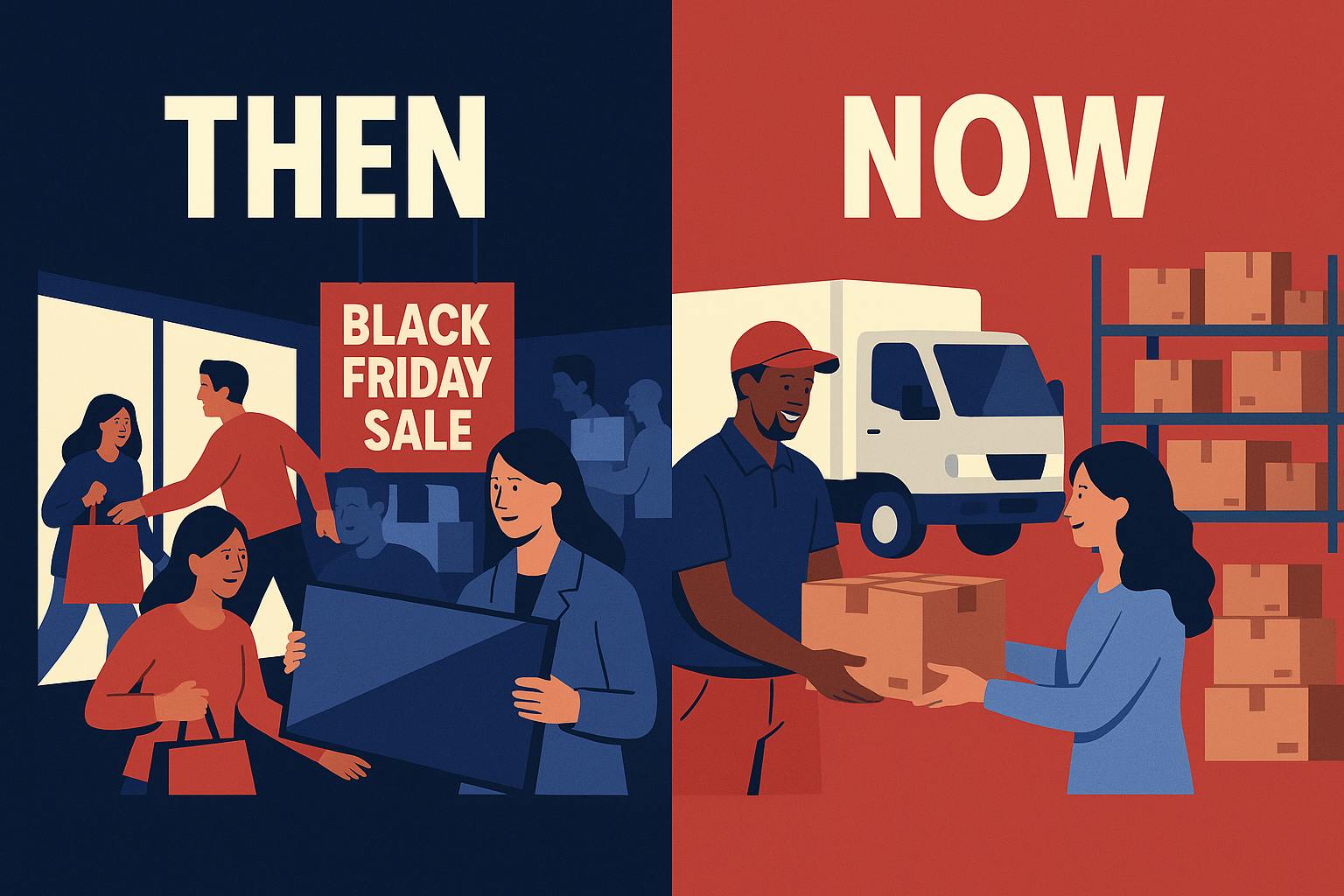
Logistics
Sep 23, 2025 - 6min read
ARTICLE
Black Friday Then vs Now: How Logistics Transformed the World's Biggest Shopping Day
Picture this: Black Friday morning, 1995. Shoppers bundled in winter coats line up outside brick-and-mortar stores at 4 AM, clutching newspaper circulars with marked deals. Fast-forward to Black Friday 2024, where consumers spent $10.8 billion online in the United States alone, with 55% of those purchases made on mobile devices. The shift isn't just digital—it's fundamentally logistical.
The biggest change to Black Friday isn't the deals themselves, but how an intricate web of global logistics, real-time tracking, and post-purchase experiences transformed what was once a single-day shopping frenzy into a complex, year-round supply chain orchestration. By examining Black Friday "then vs now," we can see how fulfillment capabilities, carrier flexibility, and customer experience innovations became the new battleground for retail success.
Black Friday Then: The Retail-Only Era
The Simple Supply Chain
In the traditional Black Friday model, logistics was refreshingly straightforward. Shoppers lined up outside stores, sometimes camping overnight for the best deals. The supply chain followed a simple path: manufacturers shipped products to distribution centers, trucks delivered weekly restocks to stores, and customers carried their purchases home in shopping bags. There was no "last-mile burden" for retailers—once you handed someone their receipt, your logistics job was done.
Limited Inventory, Physical Constraints
Back then, deals were limited to in-store stock, and shortages created chaos. If Target ran out of that discounted TV, tough luck—no real-time inventory checks across multiple locations, no ship-from-store options. The logistics challenge was relatively simple: get enough inventory to each store and hope your demand forecasting was accurate.
The One-Day Phenomenon
Black Friday was truly a single day. There was no "Cyber Week" or month-long promotions. Retailers focused their entire promotional calendar around one 24-hour period, and logistics teams planned for one massive spike in foot traffic rather than the extended, multi-channel complexity we see today.
Black Friday Now: The Digital & Global Era
The Numbers Tell the Story
Black Friday 2024 saw $10.8 billion in U.S. online sales, representing a 10.2% increase from 2023. But even more telling is the global reach: Salesforce reported that global online Black Friday sales reached $74.4 billion, with 69% of purchases made on mobile devices worldwide.
The Extended Shopping Season
Modern Black Friday promotions often start weeks before the actual day, with some retailers beginning campaigns in early November. This extended season helps manage logistics challenges but also creates sustained pressure on supply chains rather than a single-day surge.
Cross-Border Complexity
Today's Black Friday orders travel across continents, through multiple carriers, and navigate complex customs processes before reaching consumers. International shipping during this period requires streamlined customs clearance, and delays can lead to missed sales opportunities. What was once a domestic shopping day is now a global logistics event.
The Logistics Transformation
1. From Store Restocks to Real-Time Fulfillment
Then: The logistics model was simple: Truck → Store → Customer. Weekly deliveries to stores, with the occasional emergency restock during the holiday season.
Now: Businesses must adapt their strategies to handle extended peak seasons, manage multichannel inventory effectively, and meet heightened customer expectations for fast and reliable delivery. Modern retailers utilize multi-warehouse networks with real-time order routing, cross-border fulfillment capabilities, and sophisticated inventory allocation systems.
The transformation is dramatic. Where retailers once needed to predict demand for each individual store location, they now manage inventory across dozens of fulfillment centers, each capable of serving customers across multiple regions and countries.
2. From No Tracking to Full Transparency
Then: Customers left the store with their purchase in hand. Transaction complete, relationship over.
Now: Consumers expect branded tracking pages, proactive delivery notifications, and complete visibility into their order's journey from warehouse to doorstep. Providing clear, real-time order tracking can significantly enhance the customer experience and reduce the burden on your customer service team. This shift from transaction-focused to relationship-focused logistics has fundamentally changed how retailers think about the post-purchase experience.
3. From Single Carrier to Multi-Carrier Networks
Then: Most retailers worked with one regional carrier—usually whoever had the best contract for bulk deliveries to stores.
Now: Businesses need carrier flexibility to handle volume spikes and international reach. Modern retailers require diverse carrier networks to handle everything from same-day delivery in urban centers to international shipping for global customers.
The complexity is staggering. A single retailer might simultaneously coordinate with local courier services, regional parcel carriers, international freight companies, and specialized services like white glove delivery—all while maintaining visibility and control over the customer experience.
4. From "Final Sale" to Strategic Returns
Then: Black Friday often meant "final sale" signs everywhere. Returns weren't part of the business model.
Now: Return rates vary by category but often range between 15% and 30% for e-commerce apparel and electronics, with retailers increasingly focused on optimizing returns experiences. A smooth returns process can turn a potentially negative experience into a positive one and encourage repeat business. Smart retailers now view returns as a customer acquisition and retention tool rather than a cost center.
Carriyo's Role in Black Friday Today
Based on the case studies provided in the documents, modern logistics platforms like Carriyo address the complex challenges of today's Black Friday environment through several key capabilities:
Multi-Carrier Integration
With access to over 100 carriers in more than 27 countries, retailers can avoid bottlenecks and optimize delivery across their entire network. This flexibility is crucial when demand spikes overwhelm individual carriers.
Branded Tracking Pages
Rather than generic carrier tracking, retailers can maintain brand consistency throughout the post-purchase journey, keeping customers engaged and reducing "Where is my order?" inquiries.
Proactive Notifications
Automated SMS, email, and WhatsApp notifications keep customers informed about their order status, reducing customer service load during peak delivery weeks when support teams are already stretched thin.
Automated Returns Portal
Streamlined returns processing turns potential customer frustrations into loyalty-building experiences, with automated approval processes and flexible return options.
Centralized Dashboard
A single view of performance across carriers and countries allows logistics teams to identify and address bottlenecks in real-time, crucial during high-volume periods like Black Friday.
Case Study: A Retailer's Black Friday Evolution
The transformation is evident in real customer success stories. Looking at case studies from the provided documents:
Sephora's Journey: The beauty giant went from managing complex inventory management processes across 5 fulfillment centers and 50+ stores with the highest footfall in the industry to implementing an integrated inventory management and fulfillment execution workflow. The result? A 30% reduction in customer service calls within the first month and unified shipment tracking experience for all customers.
Level Shoes' Transformation: The luxury footwear retailer evolved from reviewing problems at the end of the week to fixing them before they happen, switching carriers at the flip of a switch, and achieving real-time visibility of shipment status. Their results included 96% service level across all service types and zero manual effort to manage and print shipping documents.
Black Friday 2025 and Beyond
The trends shaping the future of Black Friday logistics are already visible:
Sustainability and Transparency
Companies continue to address supply chain issues by building strong partnerships with logistics providers, looking for nearshore and domestic suppliers. Environmental consciousness is driving demand for consolidated shipping and carbon-neutral delivery options.
AI and Automation
Black Friday 2024 was a turning point for the role of AI in retail, with generative AI driving a stunning 1,800% surge in retail site traffic, and retailers using AI-driven chatbots seeing 9% higher conversion rates. AI and machine learning can help with demand forecasting, dynamic pricing, and route optimization.
Experience Over Speed
While fast delivery remains important, surveys show that about one-third of consumers value shipping cost over speed. The future belongs to retailers who can offer flexible options—same-day premium delivery, consolidated eco-friendly shipping, or convenient pickup points.
Mobile-First Logistics
With 69% of global Black Friday orders placed via mobile in 2024, logistics systems must be designed for mobile-first customer interactions, from order placement to delivery coordination.
Conclusion
Black Friday has transformed from crowded department store aisles to a complex, global supply chain orchestration that spans weeks and crosses continents. The change reflects a fundamental shift in retail: logistics evolved from a back-office cost center to a customer-facing differentiator.
The biggest deals may get shoppers to click "buy now," but logistics determine whether they become loyal customers. Around 65% of shoppers show intent for post-holiday purchases, but most new Black Friday customers make only one purchase and never return. The reason? Insufficient attention to the post-purchase experience.
Smart retailers recognize that mastering modern Black Friday means mastering logistics complexity. It's not enough to offer deep discounts—you need real-time inventory visibility across multiple channels, flexible carrier networks to handle demand spikes, proactive communication throughout the delivery journey, and streamlined returns processes that build loyalty rather than frustration.
With Carriyo's comprehensive logistics platform, retailers can master this new Black Friday reality—delivering not just orders, but trust, transparency, and exceptional experiences that keep customers coming back long after the deals end.
Ready to transform your Black Friday logistics strategy? Contact our sales team or book a demo today to see how Carriyo can help you turn logistics from a challenge into a competitive advantage.
01

Joao Vieira
CRO at CARRIYO
Inside the City: How Urban Freight and Micro-Distribution Are Redefining the Last Mile
Oct 7, 2025 - 4min read
02

Faisel Azeez
Co-Founder & CTO
Connected Fleets: How Telematics and Data Are Powering the Next Generation of Logistics
Oct 6, 2025 - 5min read
03

Joao Vieira
CRO at CARRIYO
Last Mile, First Priority: Why Experience Matters More Than Speed
Oct 2, 2025 - 5min read
Automate shipping operations and elevate post-purchase customer experience
We're trusted by

